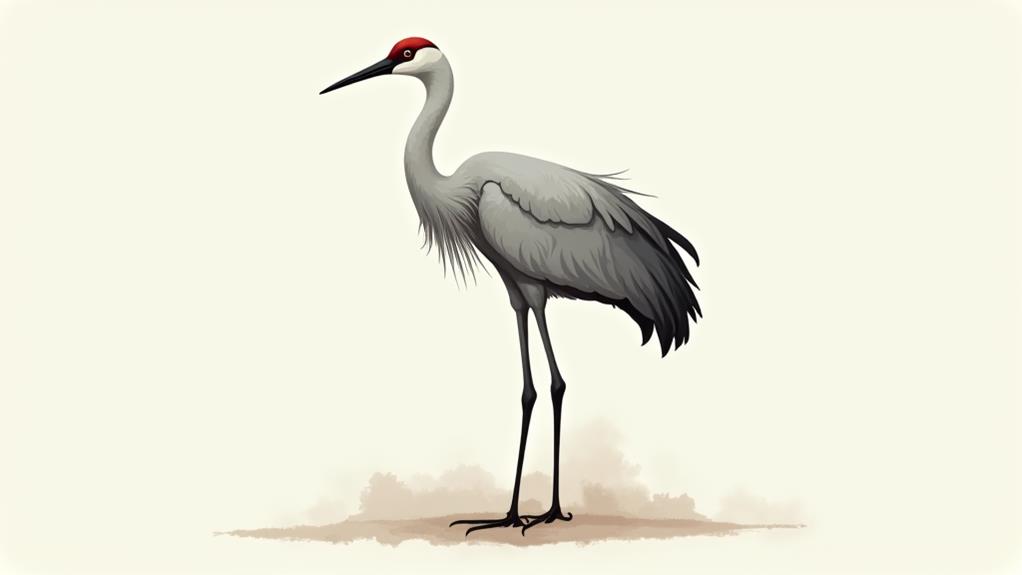You’re likely familiar with the majestic sight of cranes soaring overhead, their elegant silhouettes a stark contrast to their often-harsh habitats. Yet, despite their striking appearance, these birds remain shrouded in mystery. With 15 distinct species spread across the globe, cranes have adapted to thrive in environments as varied as the frozen tundra and subtropical wetlands. But what drives their remarkable diversity, and how do their unique characteristics impact their survival? As you explore the world of Gruidae, you’ll discover the intricate dance of biology, behavior, and habitat that has allowed these iconic birds to flourish – but also leaves them vulnerable to the challenges of a changing world.
Key Takeaways
- Gruidae, also known as cranes, are a family of birds characterized by slender bodies, long legs, and unique feather patterns.
- There are 15 crane species spread across the globe, grouped into two main genera: Grus and Anthropoides, each with distinct traits.
- Cranes inhabit diverse habitats, from Arctic tundra to subtropical regions, with wetlands being essential for breeding, foraging, and roosting.
- Cranes engage in elaborate mating rituals, cooperative breeding, and exhibit a clear social hierarchy, with dominant birds leading subordinate ones.
- Fossil records indicate that cranes have been present on Earth for at least 60 million years, with molecular phylogeny providing insights into their evolutionary history.
Physical Characteristics of Cranes

Characterized by their slender bodies and long legs, cranes possess a range of physical characteristics that distinguish them from other bird species.
You’ll notice that their feathers exhibit unique patterns, with many species displaying a mix of gray, white, and black plumage. The feather patterns on their heads, necks, and bodies often feature intricate designs, such as stripes or patches, which can vary greatly between species.
One of the most distinctive features of cranes is their beak adaptations. Their long, tapered beaks are perfectly suited for foraging in wet environments, allowing them to probe into mud and shallow water with ease.
The shape and size of their beaks also enable them to exploit a wide range of food sources, from small invertebrates to aquatic plants. Additionally, cranes’ long legs and powerful feet are well-suited for wading and walking in wet environments, making them well-adapted to their habitats.
Crane Behavior and Social Structure
As you observe cranes in their natural habitats, you’ll notice that their behavior is deeply rooted in their social structure.
Cranes are highly social birds that thrive in groups, and their behavior is shaped by their complex social dynamics.
- Mating rituals: Cranes engage in elaborate mating rituals, which involve intricate dance displays, vocalizations, and displays of plumage. These rituals play a crucial role in pair formation and bonding.
- Flock dynamics: Cranes often form large flocks, which are typically led by a dominant male. Within these flocks, individuals establish a clear hierarchy, with dominant birds leading subordinate ones.
- Communication: Cranes communicate through a range of vocalizations, including loud, trumpeting calls and soft, chirping sounds. They also use body language, such as posturing and preening, to convey information and maintain social bonds.
- Cooperative breeding: In some species, cranes engage in cooperative breeding, where multiple females lay eggs in a single nest, which is then incubated and cared for by all group members. This behavior highlights the importance of social bonds in crane society.
Habitat and Migration Patterns

Across wetlands, grasslands, and forests, cranes inhabit a diverse range of habitats, from the Arctic tundra to subtropical regions.
You’ll find them where wetlands are abundant, as they rely on these ecosystems for breeding, foraging, and roosting. Wetland conservation is crucial, as cranes are sensitive to habitat degradation and human disturbance.
Cranes are migratory birds, and their flyways often overlap with key conservation areas.
You can track their migration patterns along established flyway corridors, such as the Central Flyway in North America or the East Asian-Australasian Flyway.
These corridors are critical for crane conservation, as they provide essential stopover sites for rest and refueling during their journeys. Understanding crane migration patterns is vital for identifying areas that require conservation efforts.
As you explore crane habitats, note the importance of preserving wetland ecosystems and protecting flyway corridors to ensure the long-term survival of these magnificent birds.
Crane Species and Subspecies
With fifteen species spread across the globe, cranes exhibit remarkable diversity in their physical characteristics, behaviors, and habitats.
You’ll find that each species has unique traits that set it apart from the others. Cranes classification is a complex process that involves careful observation and analysis of these characteristics.
Cranes are grouped into two main genera: Grus and Anthropoides.
Within these genera, you’ll find various species and subspecies that have distinct features.
For instance:
- The Common Crane (Grus grus) is found in Europe and Asia, and is known for its grey plumage and distinctive call.
- The Sandhill Crane (Antigone canadensis) is found in North America, and is recognized by its rusty-red forehead and grey body.
- The Wattled Crane (Grus carunculatus) is found in sub-Saharan Africa, and is characterized by its distinctive wattles on its throat.
- The Demoiselle Crane (Grus virgo) is found in Europe and Asia, and is known for its elegant appearance and swift flight.
Understanding crane nomenclature is essential in identifying and classifying these species and subspecies.
Evolutionary History of Cranes

You’ve likely wondered how these distinct crane species and subspecies came to be.
The evolutionary history of cranes is a complex and fascinating topic that has been extensively studied.
Fossil records indicate that cranes have been present on Earth for at least 60 million years, with early fossils showing a mix of modern and ancient characteristics.
Molecular phylogeny has provided valuable insights into the relationships between crane species.
Phylogenetic analyses suggest that the most ancient crane lineage is the genus Leucogeranus, which includes the Siberian crane and the white-naped crane.
The genus Grus, which includes the common crane and the sandhill crane, is thought to have diverged from Leucogeranus around 20-30 million years ago.
Further studies have revealed that the evolution of crane species is closely tied to changes in climate and geography.
For example, the formation of the Himalayan mountain range is believed to have led to the divergence of the Himalayan crane from the common crane.
FAQs: Types of Cranes
Can Cranes Be Domesticated or Kept as Pets?
You’re wondering if cranes can be domesticated or kept as pets. While they can form strong social bonds, cranes require specific habitat adaptations, making it challenging for you to replicate their natural environment, and thus, domestication is not recommended.
Are Cranes Known to Carry Diseases or Parasites?
You’d think those majestic birds would be disease-free, but surprise! Cranes can carry avian pathogens, and as a vector, they can transmit diseases to other birds and even humans through direct contact or contaminated water and soil.
How Do Cranes React to Natural Disasters or Storms?
When you observe cranes during natural disasters or storms, you’ll notice they exhibit specific storm behavior, such as avoidance or evacuation. Their disaster preparedness includes flocking together, using wind currents, and seeking shelter in protected areas, showcasing their adaptability to harsh weather conditions.
Can Cranes Recognize Individual Humans or Faces?
You’re like a detective searching for clues, and the question is, can cranes recognize individual humans or faces? Research suggests they possess impressive intelligence, enabling facial recognition, as they can distinguish between familiar and unfamiliar humans, much like a skilled investigator.
Do Cranes Have a Unique Communication System for Warning Calls?
You’ll find that cranes employ a unique communication system, utilizing distinct vocalization patterns to convey warning calls, which are triggered by specific alarm triggers, such as predator sightings or territorial intrusions, to alert other cranes of potential threats.
Conclusion
As you delve into the world of cranes, you’ll find that these birds embody a unique blend of elegance and resilience. With their slender bodies, long legs, and striking feather patterns, they thrive in diverse habitats, from wetlands to tundras. Through their intricate mating rituals, cooperative breeding habits, and remarkable adaptability, cranes have evolved to occupy a distinct ecological niche. By understanding their biology and conservation, you’ll unlock the secrets of these iconic species and their habitats, ultimately ensuring their survival for generations to come.





